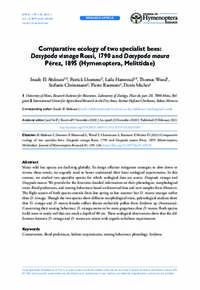Comparative ecology of two specialist bees: Dasypoda visnaga Rossi, 1790 and Dasypoda maura Pérez, 1895 (Hymenoptera, Melittidae)

Authors:
Many wild bee species are declining globally. To design efficient mitigation strategies to slow down or reverse these trends, we urgently need to better understand their basic ecological requirements. In this context, we studied two specialist species for which ecological data are scarce: Dasypoda visnaga and Dasypoda maura. We provide for the first-time detailed information on their phenologies, morphological traits, floral preferences, and nesting behaviours based on historical data and new samples from Morocco. The flight season of both species extends from late spring to late summer but D. maura emerges earlier than D. visnaga. Though the two species show different morphological traits, palynological analyses show that D. visnaga and D. maura females collect almost exclusively pollen from Scolymus sp. (Asteraceae). Concerning their nesting behaviour, D. visnaga seems to be more gregarious than D. maura. Both species build nests in sandy soil that can reach a depth of 80 cm. These ecological observations show that the differences between D. visnaga and D. maura are minor with regards to habitat requirements.
